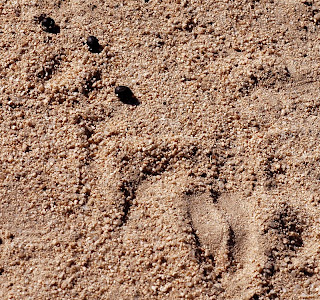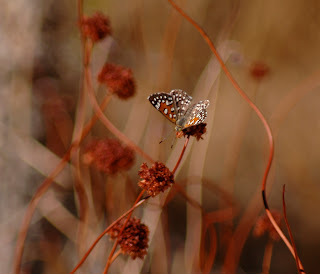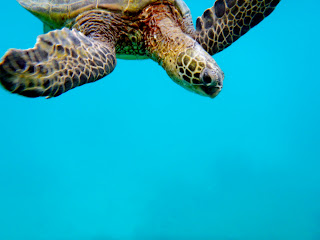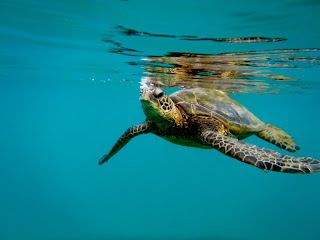
Wolf tracks in the snow, Yellowstone National Park





 After the class I went into the park to photograph the landscape. Lucky for me the moon was up and just about full.
After the class I went into the park to photograph the landscape. Lucky for me the moon was up and just about full.


 There they are, way up on the rocks high above the dam. We ended up seeing two ewes and a ram .
There they are, way up on the rocks high above the dam. We ended up seeing two ewes and a ram .


 This beautiful wasp (Scolia dubia) was getting nectar from the flowers.
This beautiful wasp (Scolia dubia) was getting nectar from the flowers.  This is a Mormon metal mark butterfly on a California buckwheat which is the food plant for its larva .
This is a Mormon metal mark butterfly on a California buckwheat which is the food plant for its larva .  Dragonflies often land on shiny car parts. Why? Maybe they see the silver shiny surfaces as looking like water.
Dragonflies often land on shiny car parts. Why? Maybe they see the silver shiny surfaces as looking like water.




 I've just come back from Maui where I had the chance to snorkel with and photograph green sea turtles (Chelonia mydas). They are called green turtles because a layer of fat just under their shell is green.
I've just come back from Maui where I had the chance to snorkel with and photograph green sea turtles (Chelonia mydas). They are called green turtles because a layer of fat just under their shell is green. They nest on sandy beaches and may feed miles and miles away from the nesting areas. These turtles are endangered in part due to loss of their nesting areas to coastal development. Turtles are also caught in fishing nets and drowned. While they can hold their breath for long periods of time, as reptiles they do need to breathe air.
They nest on sandy beaches and may feed miles and miles away from the nesting areas. These turtles are endangered in part due to loss of their nesting areas to coastal development. Turtles are also caught in fishing nets and drowned. While they can hold their breath for long periods of time, as reptiles they do need to breathe air. These turtles as adults eat algae and sea grasses. Adult turtles are preyed upon in Hawaii most commonly by the tiger sharks. I did see a turtle with what looked like teeth marks on the back of its shell.
These turtles as adults eat algae and sea grasses. Adult turtles are preyed upon in Hawaii most commonly by the tiger sharks. I did see a turtle with what looked like teeth marks on the back of its shell. After feeding the turtles often found a place under rocks or coral to rest.
After feeding the turtles often found a place under rocks or coral to rest.





 If the winter is very harsh they will continue to move to lower elevations which take them out of the park where they are hunted, or rounded up and killed because they have been exposed to a disease called brucellosis. This bacterial disease causes bison and cattle to abort calves, and can be transmitted if an animal eats grass near where another has given birth. Local ranchers are concerned that the bison could spread the disease to their cattle. Ironic since cattle gave the disease to bison in the first place.
If the winter is very harsh they will continue to move to lower elevations which take them out of the park where they are hunted, or rounded up and killed because they have been exposed to a disease called brucellosis. This bacterial disease causes bison and cattle to abort calves, and can be transmitted if an animal eats grass near where another has given birth. Local ranchers are concerned that the bison could spread the disease to their cattle. Ironic since cattle gave the disease to bison in the first place.
 These wolf tracks were in the snow by the side of the road that traverses the Lamar Valley. This is the only road open to cars in the park during the winter. Down the road to the east we came across the male wolf below at a kill made the night before.
These wolf tracks were in the snow by the side of the road that traverses the Lamar Valley. This is the only road open to cars in the park during the winter. Down the road to the east we came across the male wolf below at a kill made the night before. 90% of the time when wolves are present so are ravens. Ravens can't open the body of an elk or other large mammal by themselves, but the wolves can. Ravens have been seen playing with wolf pups as they emerge from their dens in the spring. Ravens also play with adult wolves as well as the pups. Wolves don't kill ravens, but they will kill other birds and animals that approach their kills.
90% of the time when wolves are present so are ravens. Ravens can't open the body of an elk or other large mammal by themselves, but the wolves can. Ravens have been seen playing with wolf pups as they emerge from their dens in the spring. Ravens also play with adult wolves as well as the pups. Wolves don't kill ravens, but they will kill other birds and animals that approach their kills. There is a hypothesis that ravens may even lead wolves to weak prey as they fly back and forth from the prey to the wolf pack they may be guiding wolves to specific animals the ravens have picked out as being slow, weak or ill.
There is a hypothesis that ravens may even lead wolves to weak prey as they fly back and forth from the prey to the wolf pack they may be guiding wolves to specific animals the ravens have picked out as being slow, weak or ill.
 There is alot more snow in the Lamar Valley this winter than last. All this snow makes it more difficult for the animals to more around, and some like wolves, bison and coyotes learn using the road makes traveling easier when they want to move along the valley.
There is alot more snow in the Lamar Valley this winter than last. All this snow makes it more difficult for the animals to more around, and some like wolves, bison and coyotes learn using the road makes traveling easier when they want to move along the valley. This coyote was headed up a hillside near the road, and broke through the icy crust on the snow.
This coyote was headed up a hillside near the road, and broke through the icy crust on the snow. This coyote headed toward the road. I saw it in my side view mirror, so I stopped the car and waited.
This coyote headed toward the road. I saw it in my side view mirror, so I stopped the car and waited. This mule deer had been killed either by a mountain lion or wolves. When I saw it magpies, ravens and this coyote were scavenging the remains. Wolf kills end up feeding lots of other animals.
This mule deer had been killed either by a mountain lion or wolves. When I saw it magpies, ravens and this coyote were scavenging the remains. Wolf kills end up feeding lots of other animals.
 The red fox in the foreground was hunting mice and other rodents in the snow, and did not notice the coyotes approaching it. Like wolves will kill coyotes, coyotes will kill foxes.
The red fox in the foreground was hunting mice and other rodents in the snow, and did not notice the coyotes approaching it. Like wolves will kill coyotes, coyotes will kill foxes.
 The coyotes became distracted by their own rodent hunting when they reached the area where the fox had been hunting, and the fox was able to evade them. This fox is a color variation on typical foxes and is referred to as a "black morph."
The coyotes became distracted by their own rodent hunting when they reached the area where the fox had been hunting, and the fox was able to evade them. This fox is a color variation on typical foxes and is referred to as a "black morph." This is the typical color of the red fox. We had four days of "three dog days" in Yellowstone during which we saw wolves, coyotes and foxes.
This is the typical color of the red fox. We had four days of "three dog days" in Yellowstone during which we saw wolves, coyotes and foxes.